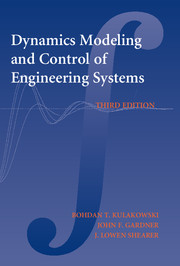Book contents
- Frontmatter
- Contents
- Preface
- Dynamic Modeling and Control of Engineering Systems
- 1 INTRODUCTION
- 2 MECHANICAL SYSTEMS
- 3 MATHEMATICAL MODELS
- 4 ANALYTICAL SOLUTIONS OF SYSTEM INPUT–OUTPUT EQUATIONS
- 5 NUMERICAL SOLUTIONS OF ORDINARY DIFFERENTIAL EQUATIONS
- 6 SIMULATION OF DYNAMIC SYSTEMS
- 7 ELECTRICAL SYSTEMS
- 8 THERMAL SYSTEMS
- 9 FLUID SYSTEMS
- 10 MIXED SYSTEMS
- 11 SYSTEM TRANSFER FUNCTIONS
- 12 FREQUENCY ANALYSIS
- 13 CLOSED-LOOP SYSTEMS AND SYSTEM STABILITY
- 14 CONTROL SYSTEMS
- 15 ANALYSIS OF DISCRETE-TIME SYSTEMS
- 16 DIGITAL CONTROL SYSTEMS
- APPENDIX 1 Fourier Series and the Fourier Transform
- APPENDIX 2 Laplace Transforms
- APPENDIX 3 MATLAB Tutorial
- APPENDIX 4 Simulink Tutorial
- Index
11 - SYSTEM TRANSFER FUNCTIONS
Published online by Cambridge University Press: 05 June 2012
- Frontmatter
- Contents
- Preface
- Dynamic Modeling and Control of Engineering Systems
- 1 INTRODUCTION
- 2 MECHANICAL SYSTEMS
- 3 MATHEMATICAL MODELS
- 4 ANALYTICAL SOLUTIONS OF SYSTEM INPUT–OUTPUT EQUATIONS
- 5 NUMERICAL SOLUTIONS OF ORDINARY DIFFERENTIAL EQUATIONS
- 6 SIMULATION OF DYNAMIC SYSTEMS
- 7 ELECTRICAL SYSTEMS
- 8 THERMAL SYSTEMS
- 9 FLUID SYSTEMS
- 10 MIXED SYSTEMS
- 11 SYSTEM TRANSFER FUNCTIONS
- 12 FREQUENCY ANALYSIS
- 13 CLOSED-LOOP SYSTEMS AND SYSTEM STABILITY
- 14 CONTROL SYSTEMS
- 15 ANALYSIS OF DISCRETE-TIME SYSTEMS
- 16 DIGITAL CONTROL SYSTEMS
- APPENDIX 1 Fourier Series and the Fourier Transform
- APPENDIX 2 Laplace Transforms
- APPENDIX 3 MATLAB Tutorial
- APPENDIX 4 Simulink Tutorial
- Index
Summary
LEARNING OBJECTIVES FOR THIS CHAPTER
11–1 To drive system transfer functions as a compact representation of relationships between inputs and outputs in linear systems.
11–2To predict time-domain system behavior by using the system transfer function.
11–3To apply the concept of the transfer function to systems with multiple inputs, multiple outputs, or both.
11–4To develop, manipulate, and interpret system transfer function block diagrams.
INTRODUCTION
A significant body of theory has been developed for analyzing linear dynamic systems without having to go through the classical methods of solving the input–output differential equations for the system. This body of theory involves the use of the complex variable s = σ + jω, sometimes known as a complex frequency variable. This variable is essentially the same as the Laplace transformation variable s in many respects, but its use does not need to involve the complex (in both senses of the word) transformation problems of ensuring convergence of integrals having limits approaching infinity, nor does it involve the need to carry out the tedious process of inverse transformation by means of partial fraction expansion and the use of a table of transformation pairs. Here the variable s is simply considered to be the coefficient in the exponential input function est, and the transfer function emerges from solving for the particular or forced part of the response to this input. The notion of transfer function is then combined with the use of simple input–output block diagrams to symbolically express the input–output characteristics of the dynamic behavior of the system.
- Type
- Chapter
- Information
- Dynamic Modeling and Control of Engineering Systems , pp. 273 - 301Publisher: Cambridge University PressPrint publication year: 2007

